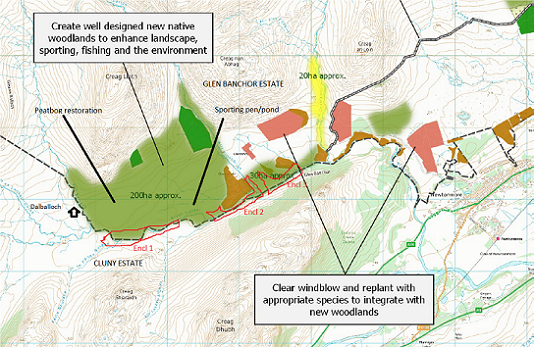
Annotated woodland plan for Glen Banchor showing a) area of peatbog restoration b) three new woodland exclosures extending across the River Calder onto the Cluny Estate c) the approx position of the sporting pond. Map Credit Cawdor Forestry.The woodland management plan contained in the latest Planning Application to build a track around Newtonmore (see here) bears little resemblance to what is happening on the ground in Glen Banchor, but then it was produced in 2018. However, it does help illustrate the interrelationships and various issues with current conservation initiatives in Glen Banchor. I will cover these in two posts, the first focusing on peat bog restoration, the second on woodland restoration in the glen and why both are likely to fail.
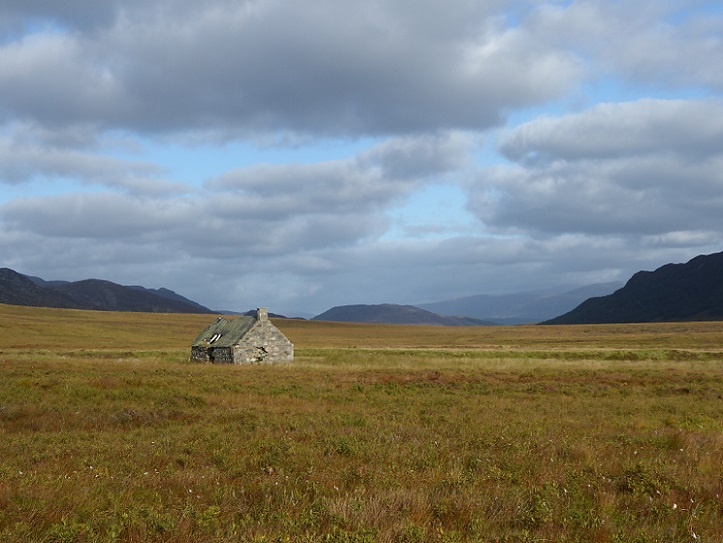
The western half of the lower ground in Glen Banchor is now predominantly peat bog, although some of it was farmed in the past. In 2018 it appears the Pitmain Estate was proposing to convert the area east of the Allt Balloch (on the far side of Dalballoch in the photo and the large green area at the top left of the map above) into new native woodlands for purposes that included “sporting” and “fishing”. I was surprised by the woodland plan not just because I knew the area was bog but because when I passed by two years later there was evidence of recent peat bog restoration work:
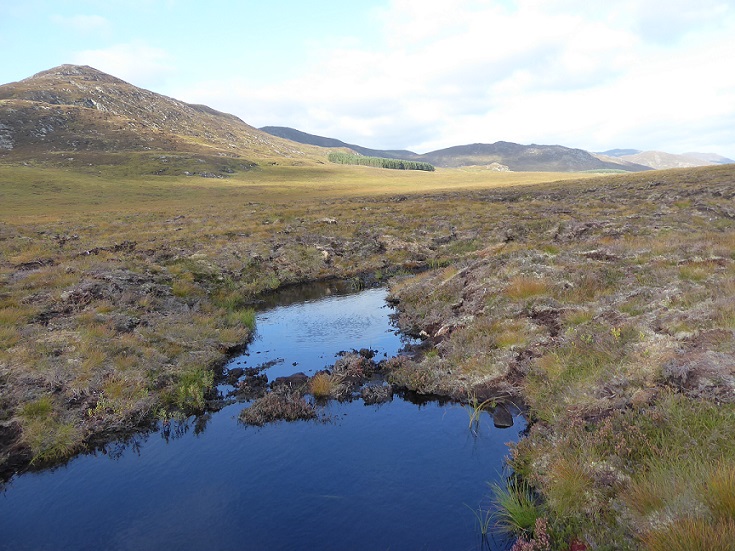
The restoration included a significant amount of water engineering, with peaty clumps of vegetation being used to split larger pools in two (as above) and in other places new pools created:
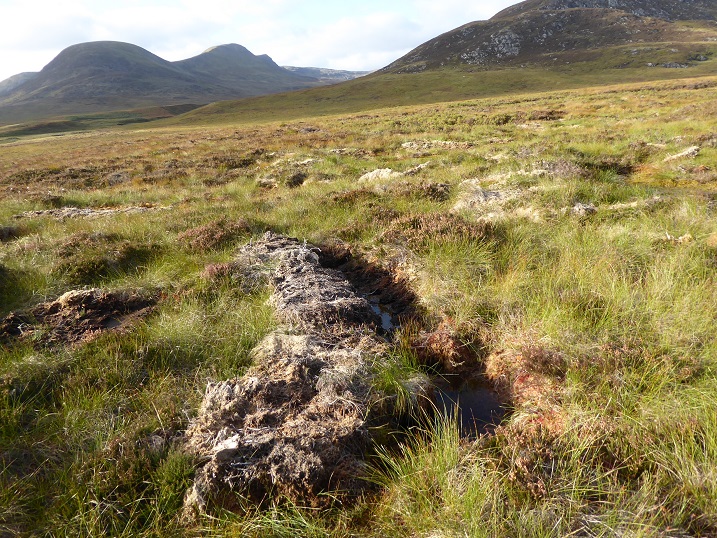
Conservationists are no longer just trying to restore bogs in Scotland, they are trying to “improve” them to fit with what experts would like them to look like. This is gardening rather than re-wilding.
Having seen the uncontrolled use of ATVs and the large herds of red deer on the Pitmain and Glenbanchor estates (see here), I wondered how long this peatbog restoration would last. So last year I returned to have a look:
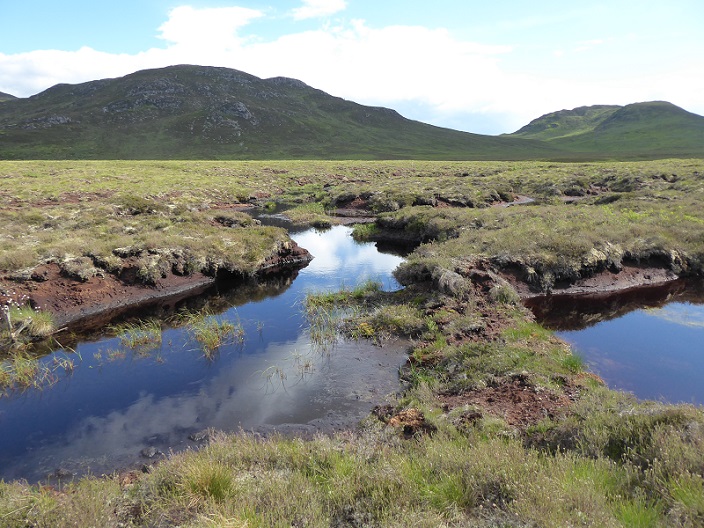
It was worse than I had anticipated. The edges of pools had in places already been eroded, perhaps by deer going for a drink, while elsewhere banks were in the process of breaking down:
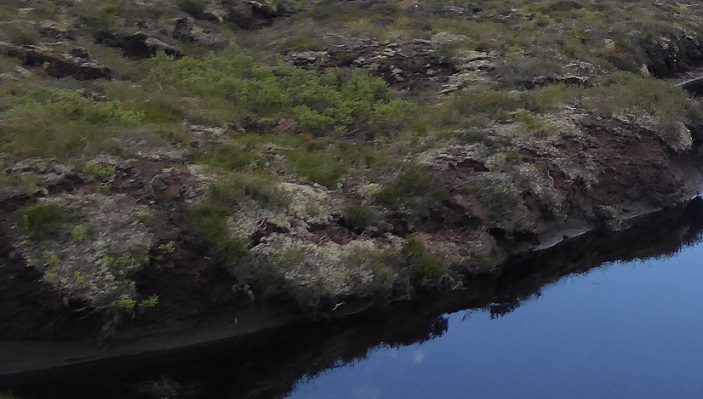
One possible explanation for this particular restoration failure is that deer legs slipped through the gaps between the “restored” clumps of vegetation prising them away from the slope (you don’t have to look far in most restoration schemes to see door hoof marks in the open spaces). Another is that the water in the bog pool has eroded the peat from underneath.
Deer hoof marks were highly visible on the low vegetated areas that had been created between the pools.

Whoever paid for this restoration work, it appears to have been a waste of money because the main reason why the bog is likely to have degraded in the first place, trampling and grazing by animals, has not been addressed.
Deer numbers and peat bog restoration in Glen Banchor
Both the Glen Banchor and Cluny estates, on the other side of the River Banchor, are part of the Monadlhliath Deer Management Group (MDMG). This agreed a “Strategic Deer Management Plan (SDMP) 2015-24” (see here). Key components of the plan were to reduce local deer densities”, which 10 years ago in the eastern Monadhliath in winter could be over 25 per square kilometre, and to start restoring damaged peat bogs. Both were worthy objectives.
The Strathcaulidh consultancy, which produced the SDMP, has since played lead role both in deer monitoring and peat bog restoration in the Monadhliath. Unfortunately, the MDMG has not updated its website since 2016 (see here) and information about peat bog restoration projects is extremely fragmented, so I have been unable to ascertain if Strathcaulidh were involved in this scheme or who paid for it (it could possibly even have been fully funded by the estate)..
In 2021, however, peat bog restoration schemes became notifiable to planning authorities and Strathcaulidh started submitting reports for the Monadhliath to Highland Council, including one for a project on another part of the Pitmain and Glen Banchor Estate (see here).
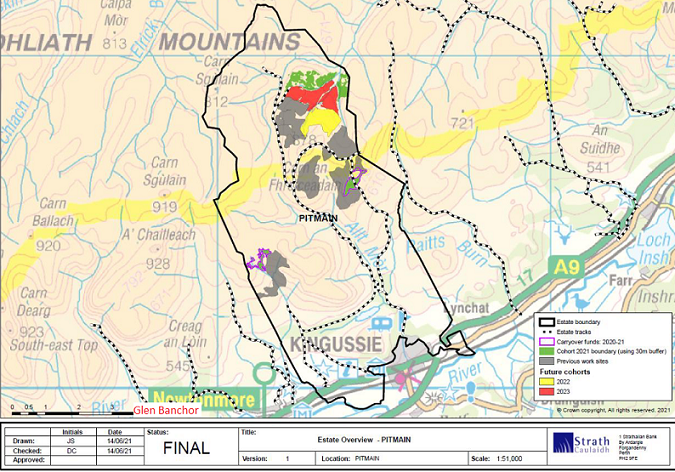
The report, which I have referred to before when discussing Strathcaulidh’s proposals to restore peatland for BrewDog at Kinrara (see here), contains some very helpful information on deer in the MDMG suggesting that numbers and deer density have reduced significantly in the last 10 years:
“A key aim of the SDMP was to reduce deer densities regionally over the course of the first 5 years of the plan. This aim was achieved by 2019, with all estates collaborating on the culls. Densities were successfully reduced to approx. 10 per km2 across the Eastern Monadhliath”.
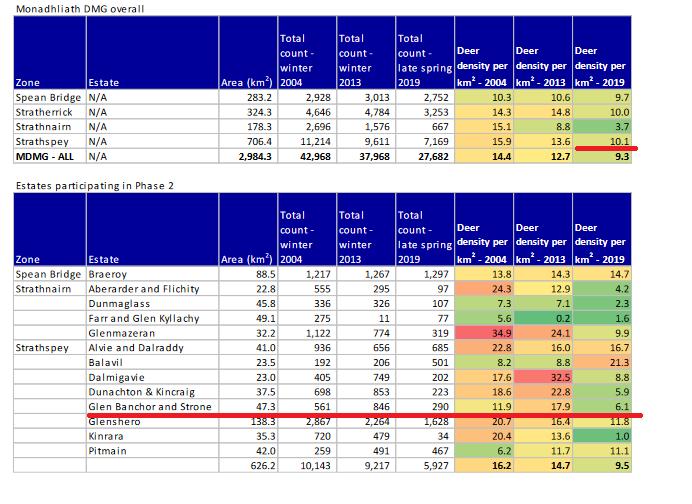
With deer moving around the Monadhliath according to season, the average figure of 10.1 for Strathspey, is likely to be more representative than the 6.1 deer per square km recorded for Glen Banchor at the time of the 2019 survey.
Strathcaulidh’s report also includes a statement on the impact of deer on peat bog restoration which I find rather less convincing:
“The MDMG has already completed over 3,500ha of peatland restoration on the estates taking part in the project. Around 1,000ha of eroding peatland was treated, with the balance involving drain blocking. Sites were treated from autumn 2017 onwards, hence a considerable number have now had 1–3 growing seasons post–treatment. The range of techniques developed specifically for the conditions found in the Monadhliath area (see Appendix 1) appear to be resistant to deer impacts in
most cases. Certainly, we have so far found very few locations where deer impacts seem likely to lead to a failure of long–term restoration outcomes.
Comment.
Work to block drains should be uncontroversial and is unlikely to be affected by grazing or trampling. Restoration of bare peat surfaces is, however, another matter and why the techniques now being used in the Monadhliath should be particularly “resistant to deer impacts” is unclear: it would be helpful to improve understanding if “the very few locations” where restoration has failed due to grazing animals were made public together with the supporting evidence.
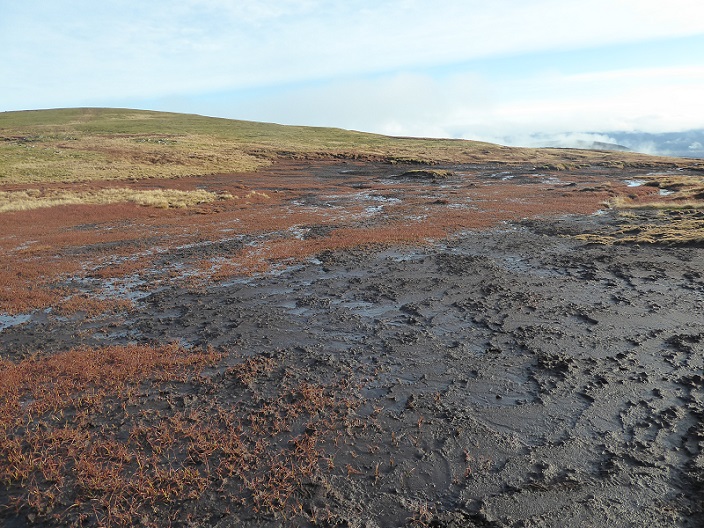
“Impacts are of course evident across most sites (e.g. heather browsing, hoof marks etc) – but damaging impacts tend to be highly localised. Moreover, damaging impacts tend to arise from a combination of circumstances (e.g. treatment having been undertaken using inappropriately small or thin turves and then trampling impacts causing some further degradation etc). It is quite often difficult in many cases to be sure that deer impacts are in fact ‘additive’. Furthermore, work from a number of deer-related studies by SCL in the Monadhliath and similar areas (e.g. Cairngorms, Caenlochan) shows deer typically use peatland much less frequently than the other habitats present. This is assumed to be because peatlands have poor-quality forage in relation to grasslands and heather moorlands. Even when deer are present in the general area the tendency will be for them to spend much of their time grazing on other habitats”.
Comment
This reads like an excuse to allow landowners to keep deer numbers high. It fails to address two fundamental questions. The first is what caused the erosion of peat bogs in the first place? If not grazing animals, what?
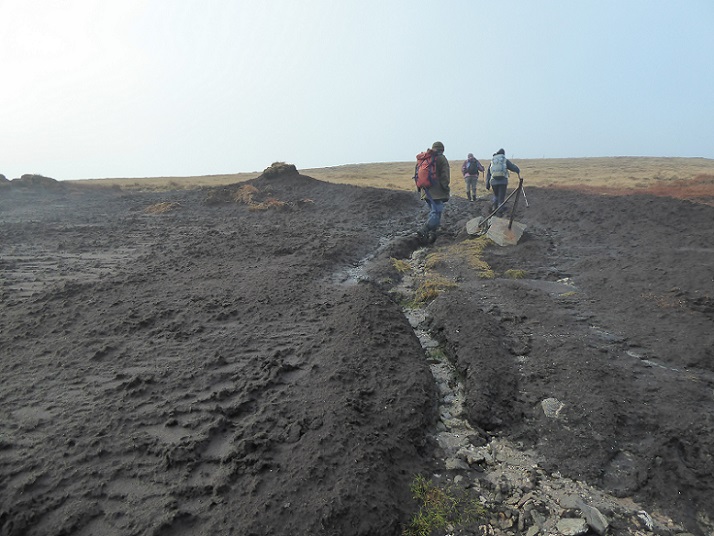
Some erosion is as a result of natural processes while both All Terrain Vehicles and walkers play a role. But none of this is can explain the 1000s of hectares of damaged peat bog in Scotland or deer wallows.
Second, Strathcaulidh’s argument also misses the main point. Peat bog are poor in nutrients and so is their vegetation, so it is obvious that deer will graze elsewhere where and when they can. But, just as deer will browse trees when hungry, so they may also browse bog vegetation. Moreover, they also cross bogs to move between areas of better grazing and will nibble anything that is palatable on the way. It is wrong therefore to imply deer grazing is not an issue. The key question is what density of deer is compatible with peatbog restoration within a given deer range?
So far most of the organisations involved in peatland restoration projects appear to have avoided this question, apparently through fear of challenging sporting estates.
Although damage by deer is part of the risk management statement for the Pitmain peat bog restoration, the risks are downplayed:
And there are not proper mitigation measures in place:
“Should deer be clearly implicated in the failure of restoration work at a significant scale on the site then the estate will consider taking a more targeted cull from in and around the restoration site. In the first instance this should simply involve taking more of the planned cull from this area. In due course, should this not have the desired effect, the estate should consider culling additional animals from the area.”
Comment
This is a non-binding commitment. Given also how Strathcaulidh emphasise in the SDMP that deer move around the Monadhliath it would appear insufficient. The key point is there in no provision that should the peatland restoration fail due to grazing and trampling, then the Scottish Government will get its (and our) money back.
In the Pitmain Prior Notification there are some photos of peat bog restoration techniques, before and after:
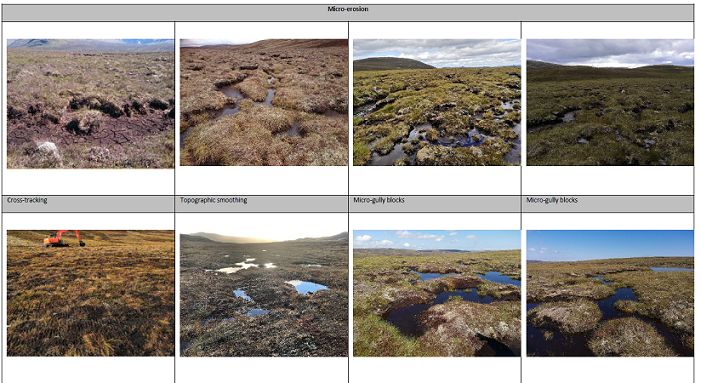
Now Strathcaulidh may have had nothing to do with the peat bog restoration in Glen Banchor – most of their work appears to be on higher ground. But the photos of how the Glen Banchor bog appeared last year were more like the top line of photos than the bottom: evidence that the restoration work has failed.
Some of this is undoubtedly due to poor restoration techniques:
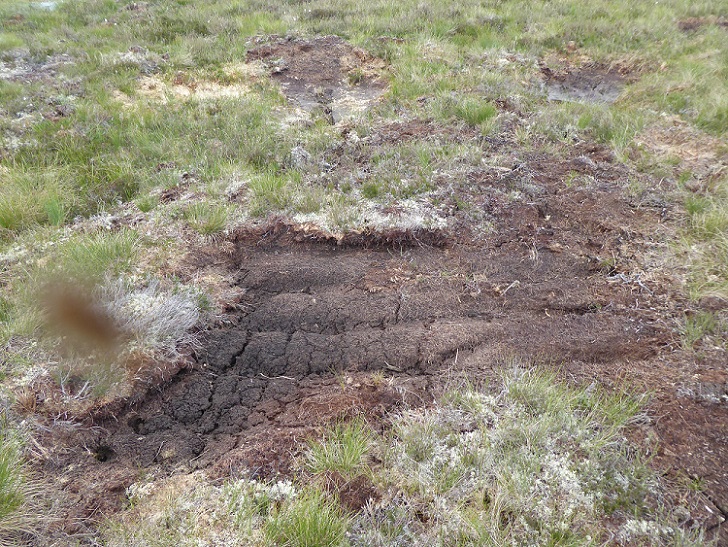
The contractor has clearly not be sent back to repair the damage. But much of the failure also appears attributable to trampling and grazing pressure:
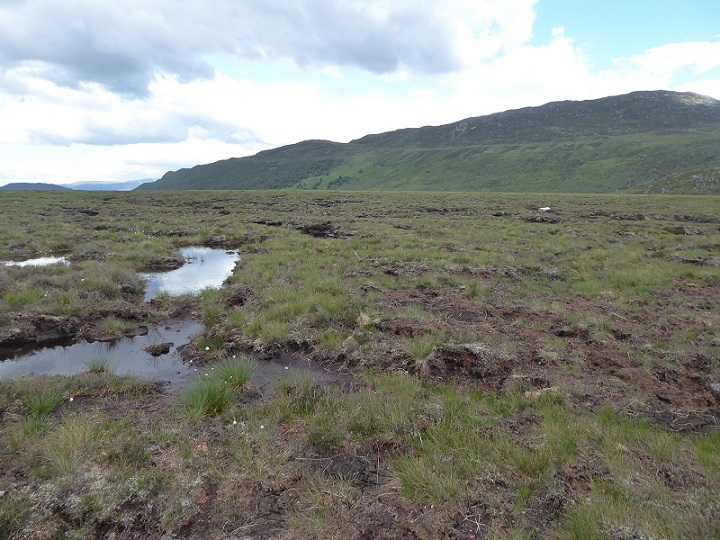
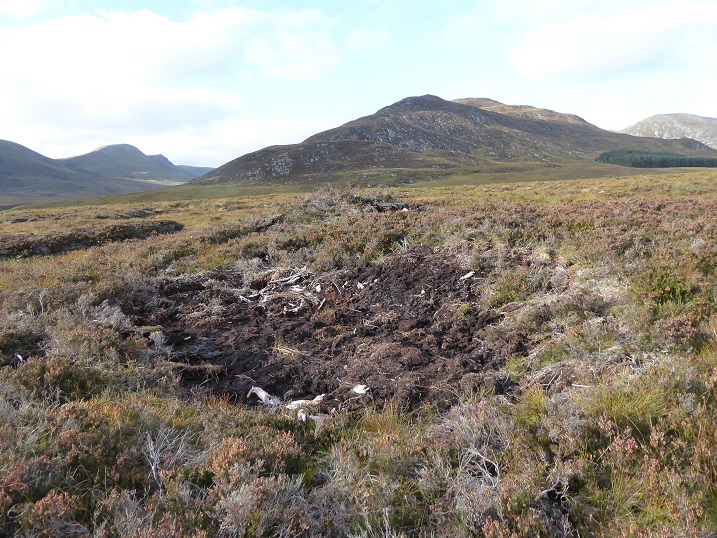
Other livestock grazing and peat bogs
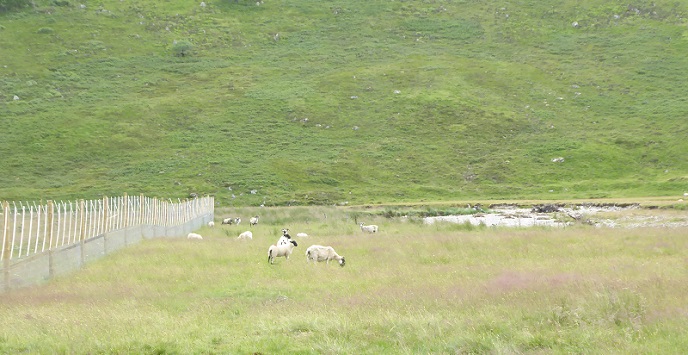
At times significant numbers of sheep are still grazing in upper Glen Banchor on the more fertile ground by the river. They are free to wander onto to the bog and although I have not seen them there they may be responsible some of the damage.
Back in 2014 Scottish Natural Heritage did publish some advice on grazing which included this for livestock (see here)

Two Livestock Units, i.e. c13 sheep, per square kilometre of peat bog looks very high to me. That density was in line with other policy thinking at the time that claimed native woodland could regenerate when deer densities reached 10 per square kilometre when we know now two deer per square km is more like it.
This high number also appears incompatible with other research (see here) which showed that:
“Bog vegetation is sensitive to trampling but Sphagnum species are especially sensitive. Repeated visits to monitoring points, even if only once a year, can kill the Sphagnum sward in the space of two or three visits, or prevent Sphagnum recovery at such locations on restoration sites.”
Try penning 13 sheep into a square kilometre of bog and stopping them from crossing the same bit of sphagnum more than a couple of times in a year!
Peat bog restoration and sporting land-use in Glen Banchor
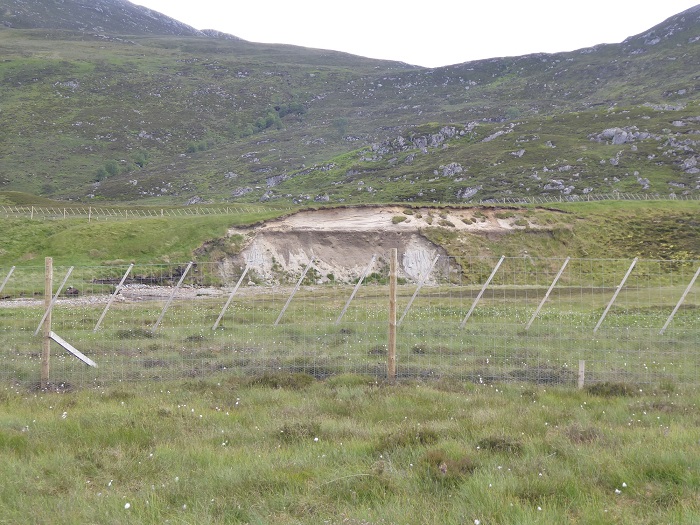
Whatever the number of sheep, add those to the 6.1 – 10.1 deer per square kilometre and it should be obvious there is significant grazing pressure in Glen Banchor. An acknowledgement of that problem are the three new exclosures which have been created along the River Calder (see map above). It appears they were necessary because the estate was not prepared to bring down the number of red deer further.
An interesting question for conservationists is why the new woodland planting merited protection but not the peat bog restoration adjacent to it?
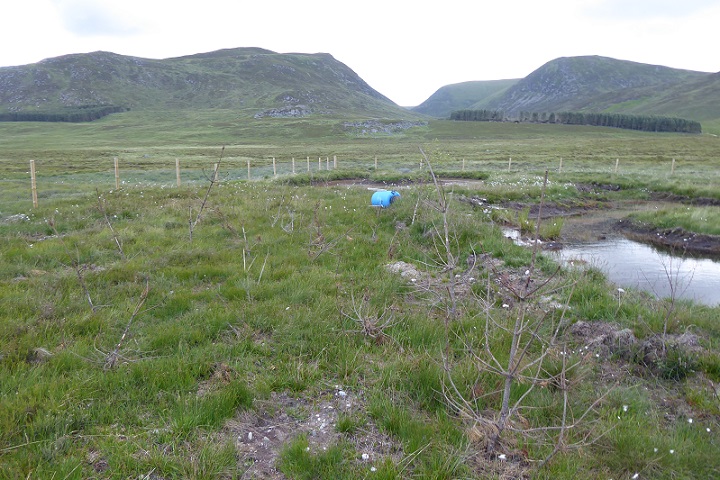
This sporting pen is consistent with the Pitmain Estate’s Woodland Management Plan of 2018 which described the woodland that was proposed here as being partly for sporting use. The peat bog restoration nearby didn’t prevent the estate from trying to plant trees, all of which have died, or from excavating a pool in the bog for sporting purposes.
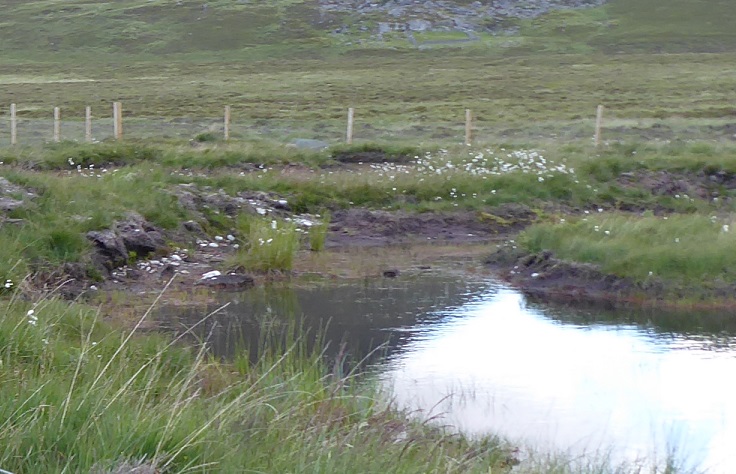
This illustrates the need for cross-compliance: why should the public fund peat bog restoration if landowners are allowed to undertake destructive land practices on areas of bog just next door?
High in Gleannn Ballach, upstream of the peat bog, is another illustration of why peat bog restoration is a waste of time unless land management for sporting purposes is brought under much tighter control:
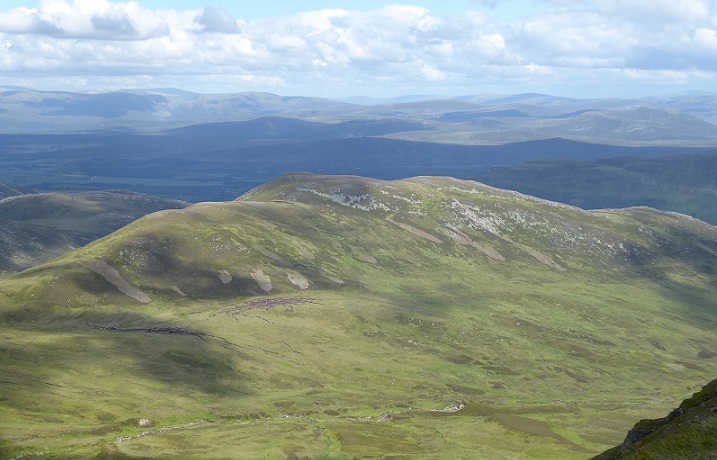
Muirburn not only prevents peat from developing, it promotes water run off. While peat bogs generally absorb water, if water starts flowing into or over a peat bog it will start to create erosion gullies and can precipitate peat slides. Such phenomena occur naturally but become unnatural and their effects accentuated where there is muirburn.
The policy point for the Scottish Government and Cairngorms National Park Authority is why would we be paying any public money to Pitmain while they continue to manage the land in a way that is destructive to peat bogs?
What needs to happen?
Peat bog restoration has generally been presented by the Scottish Government and conservation interests uncritically as a good thing, helping to reduce carbon emissions and flooding. With the Scottish Government paying for most of it, it is an easy way for sporting estates – who have been responsible directly and indirectly for much of the damage – to present their environmental credentials. Unfortunately, as managed at present, there appear no requirements for them to change how they manage the land outside of restoration areas.
Whoever paid for the peat bog restoration in Glen Banchor, it illustrates all the contradictions of current policy with grazing and muirburn continuing uninterrupted along with the development of new sporting infrastructure, such as tracks and duck ponds.
Unless all that sporting use is controlled, in ten years time the state of the environment in Glen Banchor as a whole may well be worse, not better, than it is just now even if the peat bog restoration withstands the grazing pressure and trampling longer than I predict. In my next post I will show how the woodland planting appears just as misconceived.

1 Comment on “Conservation in Glen Banchor? Peat bog and woodland restoration (1)”